Dom Edwards, the greater game support officer, shares ways to encourage physical activity away from training. Dom is an experienced youth football coach, having held roles in both the boys' and girls' games within grassroots, academy, and University football.
Playing football requires a good level of fitness to meet the demands of the game. This could be as simple as being able to run for the duration of the match or being strong enough to keep hold of the ball in a 1v1 situation. This blog will share some ideas on how you can encourage your young players to work on their physical fitness when they’re away from the pitch.
A key part of the greater game (TGG) is to encourage young people to take part in more exercise, whilst limiting things such as recreational screen time.
We know that some young people might only take part in physical activity in their PE lessons and at their grassroots football sessions. This means that outside of school they might only be physically active for one hour, plus a match day per week.
Our challenge to grassroots coaches is to think about how we can encourage the players in our care to value physical activity away from our sessions and meet the guidelines of being active for a minimum of 60 minutes per day (of which 30 minutes should take place in school).
Being physically fit will of course help on the pitch, but also has large-ranging benefits off the pitch with young people who are fitter having a lower risk of anxiety or depression.
There are several barriers to young people being able to take part in physical activity outside of organised settings. It might be that they don’t have a space to be active, motivation to be active as they have other hobbies or that they simply don’t know what to do.
A great way to encourage your team to be physically active away from training could be to create some team-based challenges for the squad. It could be as simple as giving the group a challenge to complete 300 squats between them on a certain day of the week or do 100 keepie-uppies. The group could then hold each other accountable and set themselves some targets as well. This is a great way to help them to buy into a challenge that is set.
Here’s our top tips on other things you might do to encourage physical health and wellbeing:
- For those who lack motivation – giving the young person specific challenges within their normal routine can really help. This could be as simple as challenging them to complete an exercise (e.g. 10-star jumps) between a round on their favourite video game.
- For those that might not know what to do – ask the players to buddy up and write a basic programme for each other to complete each week (something as simple as a distance to run or some bodyweight exercises to complete). This is a great way to increase buy-in as the players have more ownership of what they are doing and can share activity ideas.
- For those who might not have the space to be active – it’s not about heading out for 5km runs every other day. The key is to encourage healthy choices and habits. It might be that you could discuss with the group things such as choosing to take the stairs over the lift or walking rather than getting the bus, where they can.
Within the 12-16-year-old age group it is important to consider that they might not take part in much physical activity away from your sessions and therefore providing them with ideas of how to stay active away from the pitch can help them both on and off of it.
Perhaps consider:
- asking your players what they do away from your sessions so you can better understand which players might be doing less than the advised 60 minutes per day (of which 30 minutes should take place in school).
- giving your players some clear ideas or challenges that they could do away from the pitch to help with their physical fitness and well-being.
Some young people might not have any good ideas of what to do away from the pitch that could help them on it. What do you encourage your players to do when they’re away from your training sessions?
One of the problems for young people taking part in physical exercise away from training is that they might not have access to equipment or a safe space to do this. Have you or your club put anything in place to help with this?
Let us know below.


